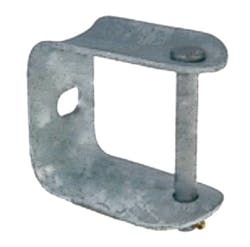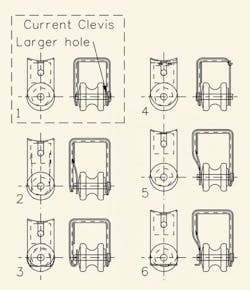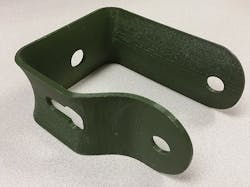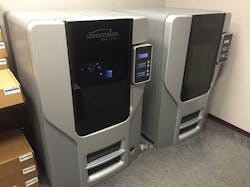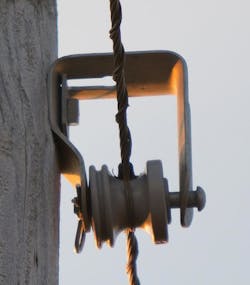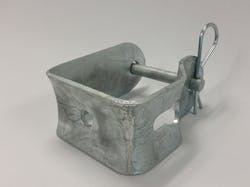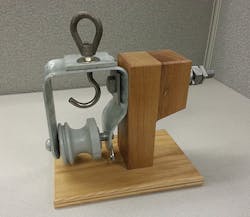When something works, it hardly pays to change it. For decades, utilities across the United States have relied on a standard, basic design for the neutral clevis. While this design worked well for most of the industry, it did not work well for Alliant Energy’s customers in Iowa and Wisconsin.
What sets apart this area of Alliant Energy is the fact it gets significant amounts of wind and ice. Alone, most systems will handle wind or ice. But when combined, which frequently happens in the open fields of Iowa and Wisconsin, the wind and ice can tear down a good system quickly. After years of study, Alliant Energy’s engineers found a common issue: the simple neutral clevis.
Clevis Problems
Along Alliant Energy’s 43,800 miles (70,489 km) of distribution lines in Iowa and Wisconsin, the under-hung neutral wire is typically attached to the pole with a metal clevis and, until recently, the clevis was bolted to the pole vertically. In other words, the pin holding the insulating spool was perpendicular to the ground, and the neutral was held against the spool with a steel tie wire. As long as the tie wire was tight, all was well.
However, there were areas where the repetitive ice and wind loading often stretched the tie. This resulted in the neutral wire resting on the bottom of the clevis and rubbing against the sharp edge of the bottom leg. In time, the motion could saw the neutral in half. The problem only affected neutrals in certain areas, but it was significant. After an ice storm caused lines to gallop, workers found up to 90% of neutrals in the affected area had some damage due to this particular issue.
Part of the problem was the size of the neutral wire. A lot of the hardware, like the clevis, was developed 50 to 70 years ago when No. 6 neutral wire was considered big. Over time, the normal size for a neutral wire has increased, but the hardware has not become more robust.
While identifying the issue was easy, finding the solution took many years of working with line mechanics and experimenting with prototypes.
Long Search
To address the problem, Alliant Energy took two different approaches. First, Alliant Energy tried to find a stronger, larger-diameter upset bolt, which proved to be difficult. The industry-standard upset bolt has a 0.625-inch (15.875-mm) diameter and standard porcelain-spool insulators were only designed to fit over a 0.625-inch bolt. Around 2008, the utility found a relatively new product: a spool insulator that would fit on a 0.75-inch (19.05-mm) bolt. Alliant Energy had custom upset bolts fabricated out of 0.75-inch steel rod.
It was a solution but very expensive, and three lengths of upset bolts were required to fit the range of pole diameters commonly used. It was not ideal because of the number of upset bolts needed and cost of the bolts, and the solution did not address the need for clevises on dead-ends. Regardless, the utility used the custom upset bolts in a limited area from March 2008 to 2012.
Second, Alliant Energy began looking for a clevis with a horizontally designed spool. This allowed the weight of the neutral to rest on the spool, and the neutral did not have to be held to the side of the spool by ties. In April 2011, a clevis design that used a threaded pin was reviewed, as it could be mounted horizontally. But there was a problem: When the pin was fully tightened, it protruded past the edge of the bracket — next to the pole — and pushed against wood. Despite this problem, the utility installed several hundred, but it was not long before reports started that the threaded pin was binding. It may have been a fabrication problem or the result of bolting the clevis to the pole, causing it to distort. In any case, a solution that did not involve a threaded pin was needed.
Engineers tried to make some minor modifications to the existing clevises and pins with little or no success. The utility decided a new design was needed, one that kept the pin horizontal and did not use a threaded pin.
Alliant Energy’s electrical standards department did some brainstorming and came up with six possible designs. They sent them to parts manufacturers to see if any were willing to help fine-tune and create the new clevis. One of those companies was Hubbell Power Systems. Alliant Energy had contacted Hubbell’s territory representative and product manager, and by the fall of 2012, Alliant Energy was working with Hubbell.
Prototypes and 3-D Prints
Of the handful of design options submitted by Alliant Energy, one was chosen. It was mounted horizontally, with one leg offset, and the upset pin was held in place by a cotter pin. Hubbell engineers used a 3-D printer to make a full-sized sample of the clevis, which is 4 inches by 7 inches by 3.5 inches (101.6 mm by 177.8 mm by 88.9 mm). The 3-D printing of the clevis was completed and sent to Alliant Energy in a matter of days. Preparing prototypes is a great use for this new technology and makes approving a new design much faster and easier.
In August 2012, Alliant Energy approved the new clevis and Hubbell started to make the investment in factory dies so they could be produced. Several thousand units were ordered, and the utility’s line crews started installing them in January 2013. However, the design improvements did not stop there.
By May 2014, a second version of the horizontal clevis was complete. Hubbell had created new 3-D models for review and then made new factory dies. The new version featured a large cotter pin — which would make it much easier for a line worker to grip while wearing thick gloves — a mounting hole instead a mounting slot and a second mounting hole. This eliminated the washer used inside the clevis to hold it securely to the pole.
Once more, Alliant Energy started purchasing the redesigned units. To date, the utility has purchased slightly more than 63,000 of the first and second versions.
While modifying a part as basic as a metal clevis may seem like an easy task, it is not.
“Electric utilities are very standards-driven,” said Jon Wilson, engineering manager for new products at Hubbell. “Every little part is well defined, so making even minor modifications can be a challenge. For example, the larger cotter key is a nonstandard part. We had to develop a special large cotter key so the linemen could more easily work with it, and the key had to be made standard.”
As installations of the second version proceeded, one more problem was identified. A lineman pointed out it took three hands to install the clevis: one to hold the neutral wire and two to install the spool insulator. The utility and Hubbell engineers began to look for solutions. One idea had the line workers temporarily install a hook to hold the neutral while installing the clevis. Sometime later, another lineman suggested pushing in part of the frame to make a hook. The hook design — now called the “finger” by line crews — was chosen and currently is being installed at Alliant Energy.
Final Design and Costs
At this point, Alliant Energy does not plan on making any more changes to the clevis design. The utility is installing the new clevis during line rebuilds, which works out to be 4,000 miles to 6,000 miles (6,437 km to 9,656 km) of distribution line per year. (Almost all of the line has an under-hung neutral, but the new clevis is not used in all cases; pole and conductor size varies and so does line design.)
While the redesigned clevis is somewhat more expensive than the standard neutral clevis, Alliant Energy is confident the cost is offset by reduced maintenance and faster installation. As for the cost of design work, while there was a time investment, Alliant Energy did not pay Hubbell for its design work or the 3-D models. Hubbell saw this as an opportunity to improve a product and meet customer needs, and the utility has been using this experience in presentations in other departments.
Importance of Collaboration
Throughout this process, Alliant Energy relied on its relationship with line mechanics and technicians to solve the problems they face in the field. The frontline workers deserve the credit for this project, because the best ideas came from the crews that work with these materials on a daily basis.
The utility also gives a lot of credit to the Hubbell representatives who took suggestions back to the factory engineering departments. Hubbell does work with utilities to create and redesign new parts on a regular basis, but those changes are typically minor and completed quickly. The project with Alliant Energy was special. Redesigning the neutral clevis was a fairly lengthy process but it was satisfying. It is nice when a utility and manufacturer can collaborate to reach a design that is a win-win.
Further, while Hubbell began this project expecting only to sell the redesigned clevis to Alliant Energy, the appeal may be broader. In the end, those involved saw how successful this project was, and Hubbell believes the new clevis might be helpful for other utilities, as well.
Mark Hamer began working for Iowa Electric Light and Power, now Alliant Energy, in 1989 as a substation and power plant mechanical drafter. He has an associate’s degree from Kirkwood Community College. He is currently working as a standards specialist in the standards department.
Dennis Dye began working for Iowa Electric Light and Power, now Alliant Energy, in 1988 as a distribution engineer. He has a bachelor’s degree in power engineering from Iowa State University. He retired at the end of 2015 as a senior engineer, standards.

